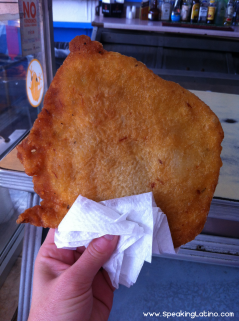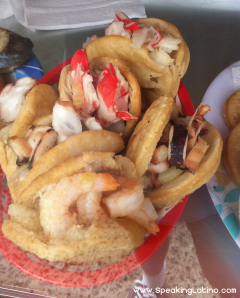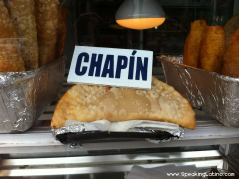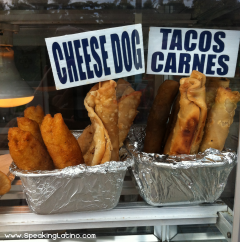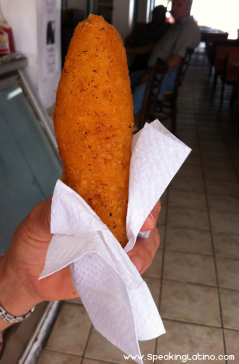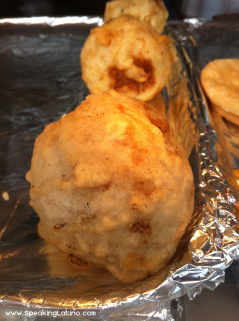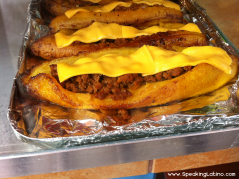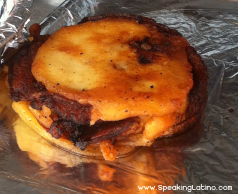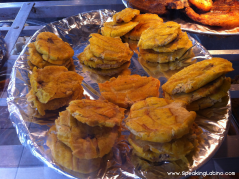The other day I spent some time at this iconic place on the northeast coast of Puerto Rico. The legendary Luquillo’s Kiosks are a group of 60 establishments that sell local food that have been around for years. My dad told me that the origins of the kiosks happened when street vendors started selling fried food to the people that visited the beach. The kiosks evolved to permanent structures built later by the government. The kiosks are numbered and have names.
Fried food terms in Puerto Rico
Before I continue with the list of fried food terms you can use to order in the kiosks, let me share what frituras are in Puerto Rico:
1. frituras: It is the generic term for fried treats. One of the characteristics of a fritura is that, in most cases, they are the handiest finger foods. A couple of napkins will be enough, and you can eat it while walking. Not all fried foods are considered frituras. For example, French fries and fried chicken are not considered frituras in Puerto Rico, since they are not traditional Puerto Rican fried foods (although both are extremely popular!).
2. cuchifrito: A synonym for fritura. It can also be used to refer to the place where frituras are sold.
3. fritanga: A variety of frituras.
4. friquitín: A place where frituras are sold. This word can also be used to refer to a low-class bar.
Understand More Puerto Ricans!
For more Puerto Rican Spanish vocabulary, check out the book Speaking Boricua: A Practical Guide to Puerto Rican Spanish to learn more slang vocabulary from Puerto Rico.
What are frituras made of?
Before we go down the list of the best frituras in Puerto Rico let me give you a quick answer about what ingredients go into the most common frituras.
As you’ll see when we look at each type of fritura (also known as fritanga) almost all contain some type of meat, like beef, pork or even crab. Many include plantains as well. And of course you cannot leave out the oil needed to fry them!
10 most common Puerto Rican frituras you will find in Los Kioskos de Luquillo
Here is my list and pictures of the most common frituras that you will find in Luquillo’s Kioks. As a disclaimer, this list can be considering the trans-fat major offenders because everything is fried in shortening (manteca).
1. Bacalaítos
Bacalaitos are salt cod fritters filled with minced cod fish with cilantro, garlic and onions. Bacalaitos paste is almost liquid, but when fried it turns crispy on the outside and chewy on the inside. This is my personal favorite!
English translation: cod fritter
2. Arepas
Every Latin American country has its own version of arepas. In Puerto Rico, arepas are made with lard, butter, flour, and baking powder. It can also be compared to fried bread. Preparation and cooking vary according to the town and family recipe. In the Kioskos de Luquillo you will find them stuffed with shrimp, king crab and octopus or ciegas –that translates to “blind” which means with no stuffing.
English translation: fried bread
3. Empanadillas and Pastelillos
Puerto Rican stuffed pastry pockets are called empanadillas or pastelillos and both are similar. The outside doughs are made of flour, salt, water, egg and shortening. The most common in the kiosks are jueyes (crab), lobster, shrimp and chapín (trunkfish). For the non-seafood fans your options are cheese, beef, chicken, and pizza (cheese and tomato sauce). The difference between the empanadilla and pastelillos resides in the size and way that they are closed. Empanadillas are bigger and twisted along the sides. In the other hand, pastelillos are smaller and closed pressing a fork around the end.
English translation: turnover
4. Tacos
These are not the traditional Mexican tacos. Puerto Rican tacos can be described as a cylindrical empanadilla. It is the same dough, stuffed with beef, rolled-up and fried. In my recent trip there were also one filled with a cheese dog, although it is not a traditional Puerto Rican option.
5. Sorullos de maíz
Sorullos are long rolls made with corn flour, salt, sugar, and butter. The sorullos that you will find in the kiosks are huge compared to the frozen ones sold at supermarkets or the ones served as appetizers in restaurants. You can dip sorullos in mayoketchup sauce (a dip made with equal parts of mayonnaise and ketchup).
English translation: corn fritters, corn sticks
6. Alcapurrias
The form is like a giant croqueta and is made with green plantain and yautía (a.k.a malanga) and pork. Some people add or substitute the yautía with yucca.
7. Relleno de papa
The traditional relleno de papa or stuffed potato is a ball of mashed potato filled with seasoned ground pork and sealed with flour. I found a cool step by step recipe with pictures here.
English translation: stuffed potato
8. Canoas
Canoas translates to canoes and as you can see in the picture, it really looks like one. Canoas are fried amarillo (sweet ripe plantain) cut in half and stuffed with ground beef. You can add cheese on top.
English translation: Beef-filled whole ripe plantains
9. Piononos
Using the same ingredients as the canoas you can make piononos. The difference is how you set up everything. Piononos are slices of ripe plantain stuck together with toothpicks and filled with seasoned ground beef.
English translation: Fried filled ripe plantain rolls
10. Tostones
The lastbut not least! Tostones are one of the most popular frituras in Puerto Rico. It is a double fried smash plantain (green) commonly used as a side dish. Just add salt and dip it on mayoketchup for extra taste! Variations are made from pana (breadfruit).
English translation: Fried plantains
Puerto Rican fritters are not the only thing that are sold in the kiosks, you will find other places such as kiosks #38 Ceviche Hut, #23 Antojitos Mexicanos and #48 Gringo’s that serves American’s favorites food such as hot dogs, hamburgers and chicken wings. And of course, lots and lots of alchohol.
So far, which Puerto Rican fritter is your favorite?
Check out these other Puerto Rican Culture articles.
